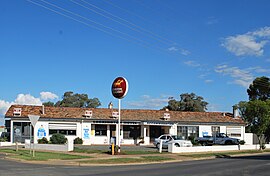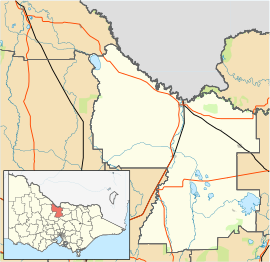
Bendigo is a city in Victoria, Australia, located in the Bendigo Valley near the geographical centre of the state and approximately 150 kilometres (93 mi) north-west of Melbourne, the state capital.
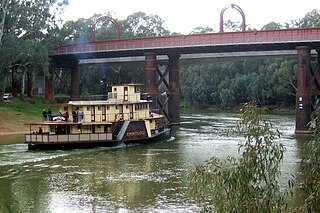
Echuca is a town on the banks of the Murray River and Campaspe River in Victoria, Australia. The border town of Moama is adjacent on the northern side of the Murray River in New South Wales. Echuca is the administrative centre and largest settlement in the Shire of Campaspe. As of the 2021 census, Echuca had a population of 15,056, and the population of the combined Echuca and Moama townships was 22,568.

Shepparton is a city located on the floodplain of the Goulburn River in northern Victoria, Australia, approximately 181 kilometres (112 mi) north-northeast of Melbourne. As of the 2021 census, the estimated population of Shepparton, including the adjacent town of Mooroopna, was 53,841.
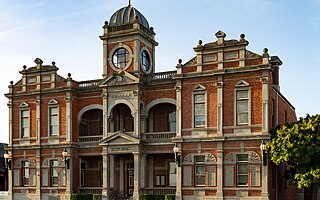
Castlemaine is a town in west central Victoria, Australia, in the Goldfields region about 120 kilometres northwest by road from Melbourne and about 40 kilometres from the major provincial centre of Bendigo. It is the administrative and economic centre of the Shire of Mount Alexander. The population at the 2021 Census was 7,506. Castlemaine was named by the chief goldfield commissioner, Captain W. Wright, in honour of his Irish uncle, Viscount Castlemaine.

Mooroopna is a town located 181 kilometres (112 mi) north of Melbourne, Victoria, Australia. It is on the banks of the Goulburn River opposite the larger town of Shepparton. The Midland Highway crosses the river between the two towns. On the 30th June 2022, Mooroopna had a population of 8,921.

Kyneton is a town in the Macedon Ranges region of West Central Victoria, Australia. The Calder Freeway bypasses Kyneton to the north and east. Kyneton is on Dja Dja Wurrung, Taungurung and Wurundjeri Woi Wurrung country.

Rochester is a town in rural Victoria, Australia. It is located 180 km (110 mi) north of Melbourne with a mixture of rural and semi-rural communities on the northern Campaspe River, between Bendigo and the Murray River port of Echuca. At the 2021 census, Rochester had a population of 3,154.

St Arnaud is a town in the Wimmera region of Victoria, Australia, 244 kilometres north west of the capital Melbourne. It is in the Shire of Northern Grampians local government area. At the 2021 census, St Arnaud had a population of 3,453.
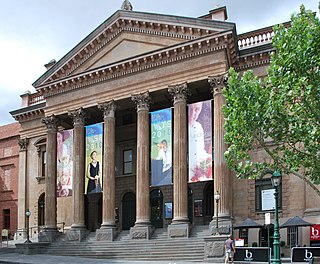
North Central Victoria is a rural region in the Australian state of Victoria. The region lies to the south of the Victorian/New South Wales border as defined by the Murray River, to the southwest of the Hume region, to the west of the Great Dividing Range contained within the Central Highlands and Victorian Alps, to the north of Greater Melbourne, to the northeast of the Wimmera, and to the east of the Mallee region.
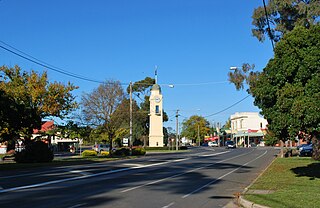
Woodend is a town in Victoria, Australia. The town is in the Shire of Macedon Ranges local government area and is bypassed to the east and north by the Calder Freeway (M79), located about halfway between Melbourne and Bendigo. At the 2021 census, Woodend had a population of 6,732 and is located on the Country of the Dja Dja Wurrung, Taungurung and Wurundjeri Woi Wurrung Peoples who are traditional custodians of this area.

The Goulburn Valley is a sub-region, part of the Hume region of the Australian state of Victoria. The sub-region consists of those areas in the catchment of the Goulburn River and other nearby streams, and is part of the Murray-Darling Basin. The Goulburn Valley is bordered on the south by the Great Dividing Range and to the north by the Murray River, the state border with New South Wales. The sub-region is one of Australia's most productive and intensively farmed areas and is predominantly irrigated.

Axedale is a town in Victoria, Australia. It is located on the McIvor Highway, in the City of Greater Bendigo, east of Bendigo. It was surveyed and proclaimed in 1861. At the 2021 census, Axedale had a population of 984.

Mia Mia is a locality of Central Victoria, Australia, 119 kilometres (74 mi) north of Melbourne and 56 kilometres (35 mi) south of Bendigo. It is largely an area of broadacre farms raising cattle and sheep. It is a part of the Heathcote wine region Wine District and a number of vineyards have been established in the area, most notably producing Shiraz grapes. Its local government areas are the City of Greater Bendigo and Shire of Mitchell, Mia Mia is part of the Federal Electorates of Bendigo and McEwen and it is in the state electorate of Euroa. In 2011, it had a population of 265.

Ultima is a town and district in northern Victoria, Australia. The town is in the Rural City of Swan Hill local government area, 353 kilometres (219 mi) north-west of the state capital, Melbourne and 35 kilometres (22 mi) south-west of Swan Hill. At the 2021 Census Ultima had a population of 173, down from 333 in 2011.
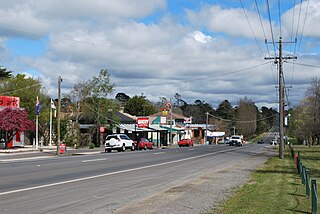
Malmsbury is a town in central Victoria, Australia on the Old Calder Highway (C794), 95 km north-west of the state capital, Melbourne and 11 km north-west of Kyneton. Situated close by the Coliban River, Malmsbury has a population of 1,101. Malmsbury is in the north western area of the Shire of Macedon Ranges local government area.
The Heathcote District Football League (HDFL) is an Australian rules football league based in the Heathcote region and major Bendigo area with clubs based in the regions of City of Greater Bendigo, Shire of Campaspe, and Shire of Gannawarra

Toolleen is a town in northern Victoria, Australia. The town is on the Northern Highway and is in the Shire of Campaspe and the City of Greater Bendigo local government areas, 142 kilometres (88 mi) north of the state capital, Melbourne. At the 2016 census, Toolleen and the surrounding area had a population of 182.
Bamawm is a locality in the Australian state of Victoria. The district is located in the Campaspe Shire local government area, 215 kilometres (134 mi) north of the state capital, Melbourne. At the 2011 census, Bawmawm and the surrounding area had a population of 527. Bamawm shares a cricket club with Lockington, their home ground is the Bamawm sports stadium.

John Hunter Kerr (1820–1874) was a Scottish-born grazier, amateur photographer and collector of Indigenous artefacts in Victoria, Australia, during the mid-nineteenth century. He was the fourth son of Captain A R. Kerr, R.N., C B, and brother of Vice-Admiral R. Kerr.

Tennyson is a locality in north central Victoria, Australia. The locality is in the Shire of Campaspe, 209 kilometres (130 mi) north west of the state capital, Melbourne.
